Sudan Conflict: “I saw many corpses on my way” – Stories from the massive influx of wounded Sudanese in eastern Chad
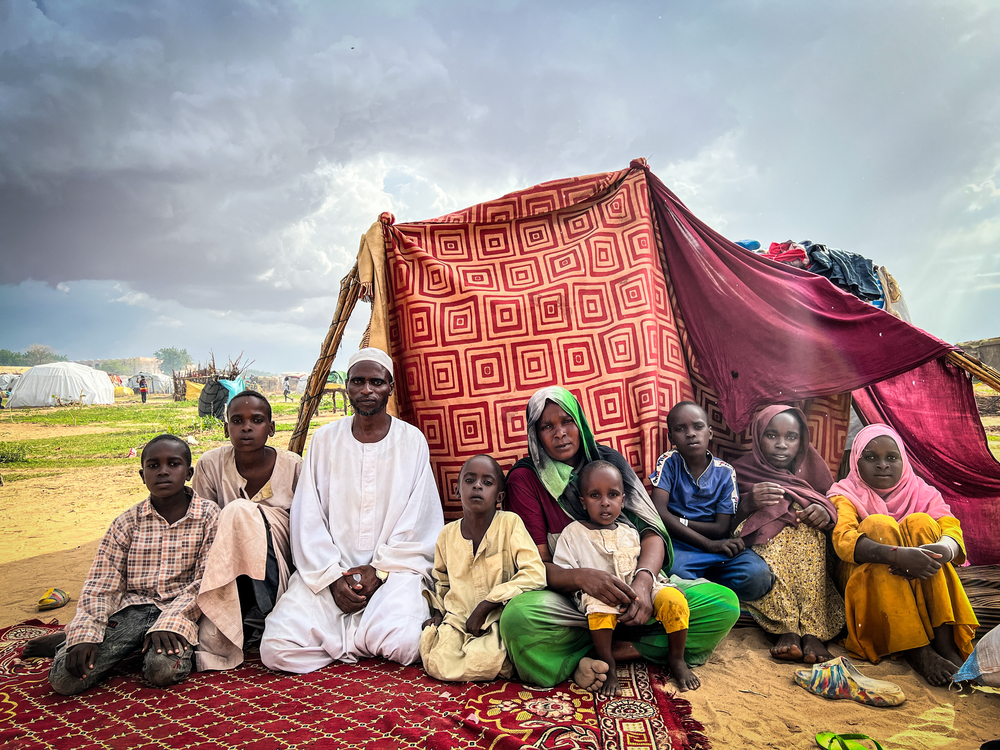
By the time the current conflict in Sudan broke out in mid-April, its Darfur region had already been facing war and ethnic violence for over two decades. Today’s fighting – which first erupted in Khartoum between the Sudanese Armed Forces (SAF) and the paramilitary Rapid Support Forces (RSF)—has rekindled fault lines in communities throughout Darfur, particularly the city of El Geneina.
Intense fighting, intercommunal violence, and large-scale attacks against civilians have driven hundreds of thousands of people to flee across the border to Adré, eastern Chad. Like other towns along the Chad-Sudan border, Adré has been struggling to accommodate the rapid, massive influx of refugees as access to food, medical care, and other necessities was already limited before their arrival.
Médecins Sans Frontières teams have been providing care in Adré since 2021, but operations have scaled up significantly over the past three months to expand capacity in local health care facilities and improve the quality of care as large numbers of people continue to arrive from Sudan—often with gunshot wounds and other injuries sustained along the way from El Geneina. In testimonies gathered in recent weeks, many patients said they were victims of Arab militias inside El Geneina and during their flight to Chad. They report being targeted because of their Masalit identity.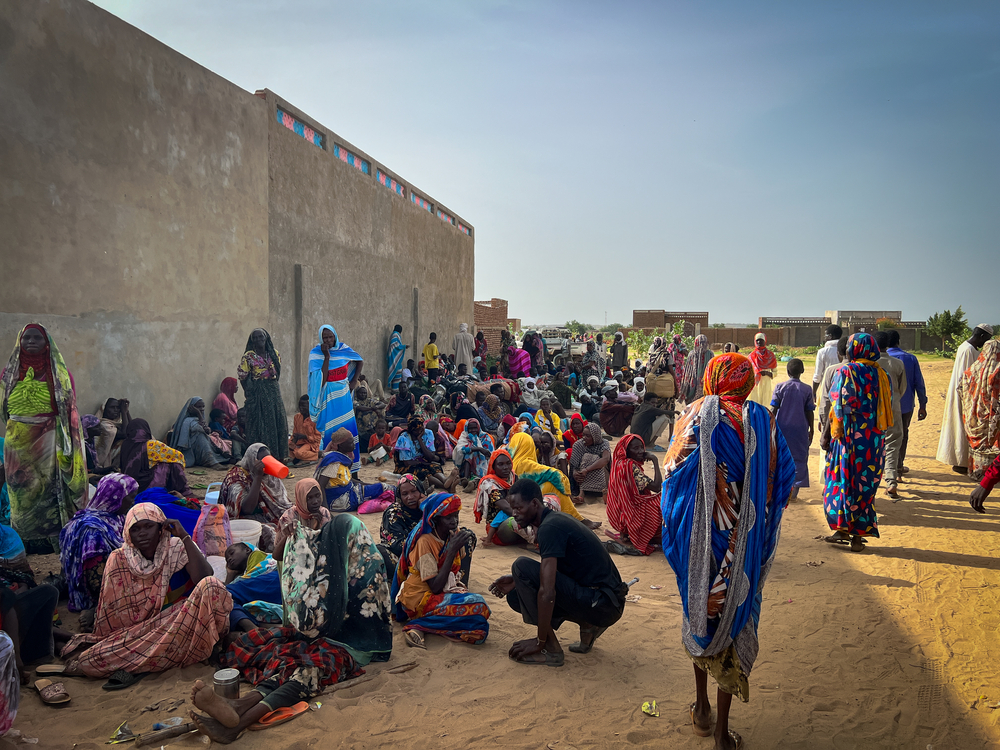
“We didn’t expect so many wounded”
At the end of May and beginning of June, the violence intensified in West Darfur. Yet only a few wounded people managed to escape across the border to an emergency surgical unit set up by MSF teams in partnership with the Chadian Ministry of Health in Adré hospital.
Most had gunshot wounds and came from the town of Masterei and its surroundings, south of El-Geneina. Upon reaching the Chadian town of Goungour, they received care from Ministry of Health and MSF medical staff and were referred to hospital.
Everything changed on June 15 when people managed to escape to Adré after being stranded for two months in El Geneina. Adré hospital received 261 war-wounded patients on that day alone. Dr. Papi Maloba, the only MSF surgeon present in Adré at that time, had started the day as usual: after making his round of the patients and selecting those who were to go into the surgical room, he and his team began operating on a young boy.
“Suddenly the calls started: ‘Come on, come on, there are patients arriving from everywhere! I explained to my colleagues that we couldn't leave this patient with an open abdomen. In the operation room, everything was calm, but outside there was a great deal of commotion. There were vehicles from the joint Chad-Sudan military force bringing in patients; MSF teams bringing in patients; others arriving on donkey carts or carried by relatives.
The hospital was transformed into a veritable camp in less than two hours. We were prepared, but we weren't expecting so many wounded patients all at once. We thought that the next day would be a bit calmer. It turned out to be worse: The next day we received close to 400 new casualties." — Dr. Papi Maloba, MSF surgeon
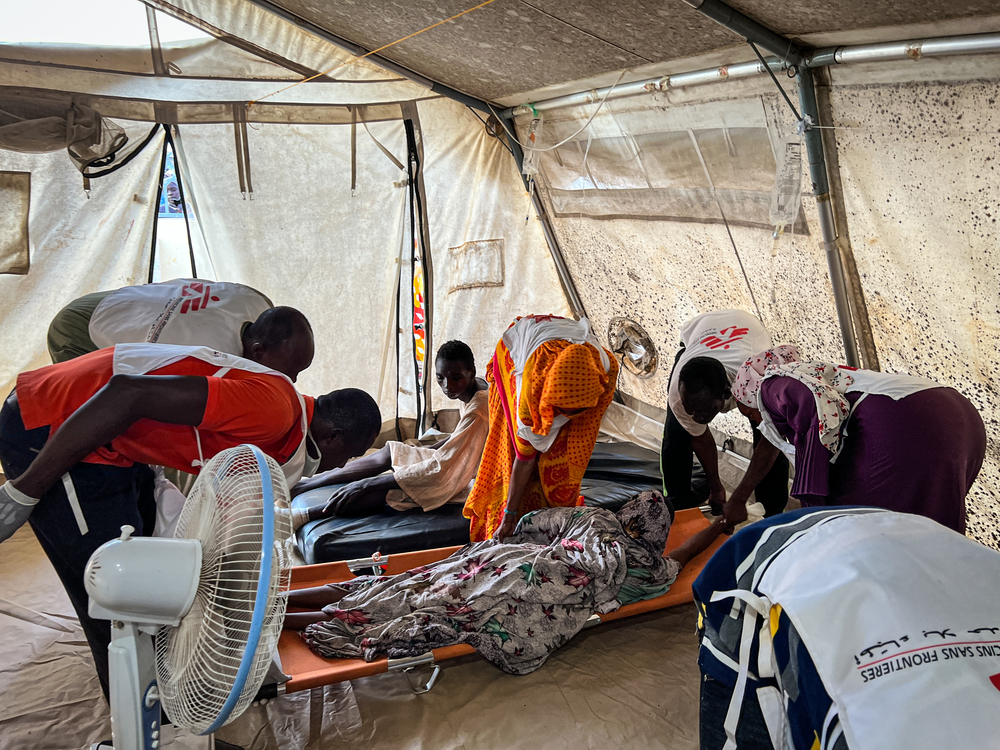 858 war-wounded patients in just three days
858 war-wounded patients in just three days
This influx of casualties at Adré hospital was one of the largest, in terms of volume, that our teams have ever seen, with 858 war-wounded people received from June 15 to 17. Over the following days, the emergency room received an average of 46 wounded patients each day. From June 25 through the end of July, the average decreased to 10 or fewer patients each day.
The vast majority of patients were suffering multiple gunshot wounds, particularly to the abdomen, back, and legs. They were mainly men, with a smaller proportion of women and children. The youngest patient hospitalized was two months old; the oldest was over 70.
Around 47 percent of patients were assessed as green cases and were able to walk. About 49.5 percent were classified as "yellow cases," or those who needed treatment but whose general condition allowed them to wait without critically worsening their prognosis, 3.4 percent were absolute emergencies requiring very quick treatment, classified as “red cases.” The high proportion of "green" and "yellow" cases suggests that it was only those stable enough to undertake the journey to Chad who were able to reach our medical services. Many others in more critical condition were left behind in Darfur.
Between June 15-18, 62 pregnant women received care for gunshot wounds and injuries from beatings and other assaults. “The first patient I was called in to see was a woman who had been shot in the stomach and chest while she was six months pregnant. We were very afraid for her because a piece of bullet was lodged in her uterus. It was striking to see so many pregnant women with injuries to their limbs and abdomens. They reported terrible scenes such as having to run under bullets at the risk of losing their children on the way, and being attacked and raped.” — Clémence Chbat, MSF midwife
Testimonies describing violence targeting certain ethnicities
With a few exceptions, the wounded patients at Adré hospital belong to the Masalit ethnic group, a non-Arab Darfuri community that lives in both Chad and Sudan. Before the conflict, there was already a large Masalit community in Adré, which partly explains why those fleeing violence sought refuge there. The stories they share reflect the experience of the Masalit people of El Geneina—an experience that doesn’t represent the whole population of West Darfur or El Geneina.
“When the war got worse between the Sudanese army and the RSF [Rapid Support Forces], El Geneina descended into chaos. Violence and theft spread between Masalit and Arab tribes because the government and police forces disappeared from the city. At first, I had no plan to leave El Geneina. Me and my two daughters along with my mother and four of my sisters moved to a collective shelter in the Al Madares neighbourhood. However, the neighbourhood was under constant bombing and shooting. Arab militias were targeting civilians in shelters and compounds. Then, Arab militias attacked us in the shelter. They told us that this wasn’t our country and gave us two options: immediately leave for Chad or be killed. They took some men and I saw them shooting them in the streets, with no one to bury the corpses. So we fled in a big group” — H, 26 years old
Several testimonies echo similar threats and report recurring attacks in neighbourhoods, as well as the presence of snipers targeting civilians venturing out to fetch water or supplies.
“No one was allowed to go in or out [of their home]. People tried to get clean water from some wadis or springs, but snipers were shooting at them.” — N, 25 years old
Other patients recall continued ethnic-based violence on the road to Chad and its dozens of checkpoints.
“On the road to Chad, we were stopped at many checkpoints. They were asking us what tribe we were from. They were targeting Masalit. I am from the Al Fur tribe. I saw them telling Masalit people to leave the cars and I don’t know what happened to them because we drove off.” — M, 35 years old
“On June 18, I paid an Arab armed driver 300,000 Sudanese pounds [about $500 USD] to get my wife and children to Adré. I couldn’t leave with them because the driver said it wasn’t safe for my family if I’m around, they will know we’re from Masalit tribe. On June 25, I went out to the hills in northern El Geneina to try get some mobile signal. I saw at least 20 bodies when I looked down the valley. I left on June 28 and at all the checkpoints, the driver said “he’s one of us,” and we were fine. Many people didn’t make it to Chad and were killed just because they were Masalit.” — K. 44 years old
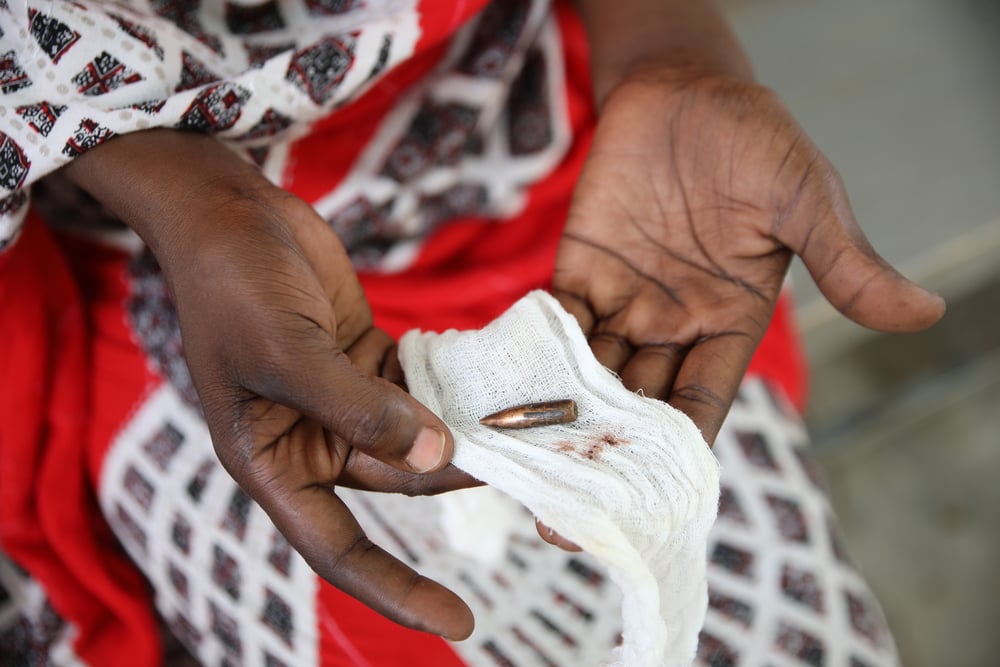
A variety of factors prompted a large part of the Masalit population of El Geneina to try to flee to Chad in mid-June, after several weeks of clashes and violence: the murder of the governor of West Darfur, Khamis Abakar; escalating threats; and reports of a massacre during an attempt to reach a Sudanese army camp in Ardamatta, an area in the eastern part of the town.
“On the evening of Wednesday June 14, I left home with my family along with around 200 people toward Ardamatta in northeast El Geneina. When we reached the Al Naseem area, they started shooting at us from the roofs of buildings. They killed many of us, it was a massacre. We couldn’t help or carry the dead and wounded, everyone was running for his life. I ran with my wife, our one-year-old baby, and a small group of other people. We reached the Al Madares neighbourhood and continued forward. We headed west and faced more Arab militias who took our money and phones. Eight of my children are in Ardamatta military camp and I don’t know if they are doing well because communication is so difficult. I hope they are safe.” — A, 40 years old
It was the only escape route, but the journey to Chad was nonetheless extremely dangerous. Patients said that they had used various means to get there: on foot, in convoys, and in vehicles whose drivers could guarantee passage for large sums of money. In addition to the risk of being robbed, assaulted, raped, or killed at checkpoints, many patients reported that armed men shot at people fleeing. The town of Shukri is mentioned in several accounts as one of the most dangerous points on the route.
“Women and children gathered [in the] Al Jamarik area at 4 a.m. Our plan was to start marching west [to Chad]. Then men joined [us]—some had guns and cars to defend the people along the way. We were attacked while crossing a town called Shukri. Many were killed by the locals. Those who didn’t die there, it’s because they were further away from the shooters or other people in front of them took the bullets. That’s the only way some of us got to survive.” — L, 36 years old
“At Shukri, a small group stopped us and asked us to sit down. It was like Judgement Day. I was scared. [They said], ‘All slaves must stand up and if you want to live, leave Sudan because Sudan is for Arabs.’ We started running and the armed men were shooting at people at random. I was shot in the right foot. I was bleeding but I didn't stop walking. At one point I took my white turban, wrapped my foot in it, and I didn't stop even though I was tired, dizzy, and had a bad headache. Everywhere I looked, I saw death. Believe it or not, death has a smell, and I could smell it. I saw many corpses on my way. I thought I might be joining those corpses in a few moments. But fortunately, we reached the border. That's when I saw a white SUV belonging to Médecins Sans Frontières, which picked me up and took us to the hospital in Adré.” — C, 40 years old
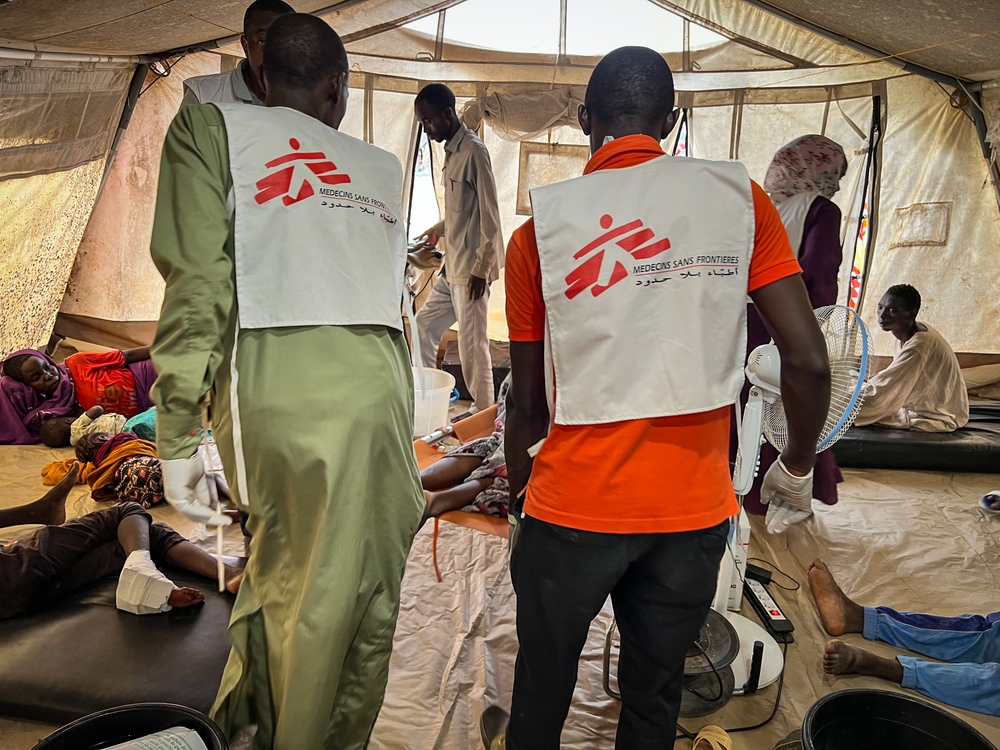
A growing humanitarian crisis
Today, around 200 injured people remain in the hospital in Adré. Some of them will need medical follow up for a long time in order to recover, particularly physiotherapy. At the end of June, MSF set up and started working in its inflatable hospital, including a sterilization and X-ray room and two operating rooms, to improve the available capacity and quality of care.
With the wave of wounded, new refugees from El Geneina also arrived in Adré. According to the United Nations High Commissioner for Refugees (UNHCR), around 130,000 refugees, mainly women and children, have arrived in the town in recent weeks. This sudden increase in the population is generating major humanitarian needs in all areas: medical care, shelter, food aid, water and sanitation.
The authorities and the UNHCR estimate that there were 260,000 new Sudanese refugees in eastern Chad in mid-July.
Transit sites are multiplying, and new camps are being set up, including in Arkoum, where MSF has started providing medical care. Some 400,000 Sudanese refugees were already in Chad before this current conflict, having fled their country during the last 20 years. A large amount of humanitarian aid will have to be provided over the long run to support the most vulnerable, whether Chadians or refugees, and help absorb the shockwaves of Sudan’s conflict in an area already marked by food insecurity and lack of access to water and health care.





Leave a Comment